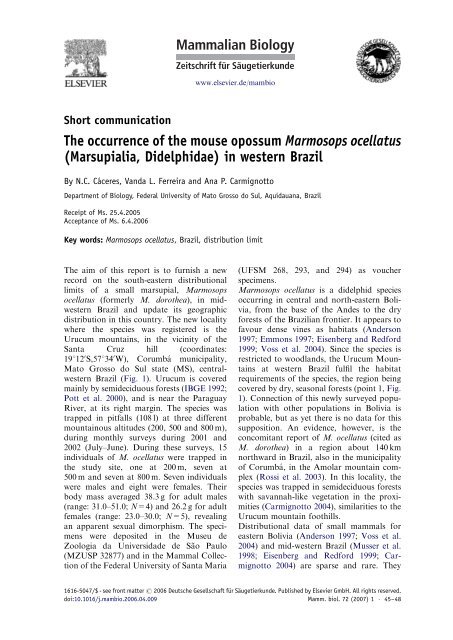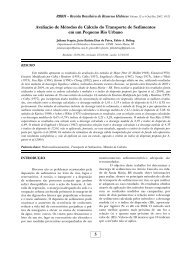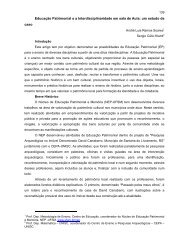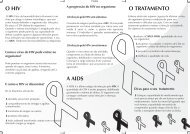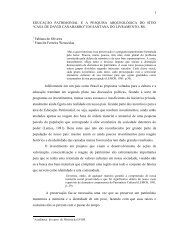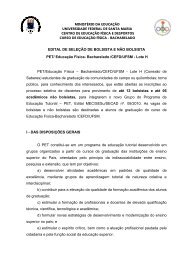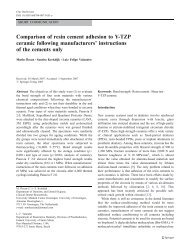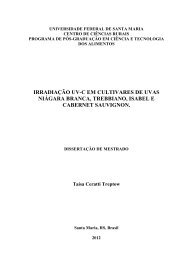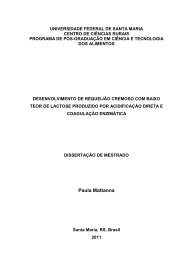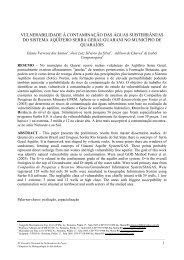The occurrence of the mouse opossum Marmosops ocellatus - UFSM
The occurrence of the mouse opossum Marmosops ocellatus - UFSM
The occurrence of the mouse opossum Marmosops ocellatus - UFSM
Create successful ePaper yourself
Turn your PDF publications into a flip-book with our unique Google optimized e-Paper software.
Short communication<br />
www.elsevier.de/mambio<br />
<strong>The</strong> <strong>occurrence</strong> <strong>of</strong> <strong>the</strong> <strong>mouse</strong> <strong>opossum</strong> <strong>Marmosops</strong> <strong>ocellatus</strong><br />
(Marsupialia, Didelphidae) in western Brazil<br />
By N.C. Cáceres, Vanda L. Ferreira and Ana P. Carmignotto<br />
Department <strong>of</strong> Biology, Federal University <strong>of</strong> Mato Grosso do Sul, Aquidauana, Brazil<br />
Receipt <strong>of</strong> Ms. 25.4.2005<br />
Acceptance <strong>of</strong> Ms. 6.4.2006<br />
Key words: <strong>Marmosops</strong> <strong>ocellatus</strong>, Brazil, distribution limit<br />
<strong>The</strong> aim <strong>of</strong> this report is to furnish a new<br />
record on <strong>the</strong> south-eastern distributional<br />
limits <strong>of</strong> a small marsupial, <strong>Marmosops</strong><br />
<strong>ocellatus</strong> (formerly M. doro<strong>the</strong>a), in midwestern<br />
Brazil and update its geographic<br />
distribution in this country. <strong>The</strong> new locality<br />
where <strong>the</strong> species was registered is <strong>the</strong><br />
Urucum mountains, in <strong>the</strong> vicinity <strong>of</strong> <strong>the</strong><br />
Santa Cruz hill (coordinates:<br />
19112 0 S,57134 0 W), Corumba´ municipality,<br />
Mato Grosso do Sul state (MS), centralwestern<br />
Brazil (Fig. 1). Urucum is covered<br />
mainly by semideciduous forests (IBGE 1992;<br />
Pott et al. 2000), and is near <strong>the</strong> Paraguay<br />
River, at its right margin. <strong>The</strong> species was<br />
trapped in pitfalls (108 l) at three different<br />
mountainous altitudes (200, 500 and 800 m),<br />
during monthly surveys during 2001 and<br />
2002 (July–June). During <strong>the</strong>se surveys, 15<br />
individuals <strong>of</strong> M. <strong>ocellatus</strong> were trapped in<br />
<strong>the</strong> study site, one at 200 m, seven at<br />
500 m and seven at 800 m. Seven individuals<br />
were males and eight were females. <strong>The</strong>ir<br />
body mass averaged 38.3 g for adult males<br />
(range: 31.0–51.0; N=4) and 26.2 g for adult<br />
females (range: 23.0–30.0; N=5), revealing<br />
an apparent sexual dimorphism. <strong>The</strong> specimens<br />
were deposited in <strong>the</strong> Museu de<br />
Zoologia da Universidade de São Paulo<br />
(MZUSP 32877) and in <strong>the</strong> Mammal Collection<br />
<strong>of</strong> <strong>the</strong> Federal University <strong>of</strong> Santa Maria<br />
ARTICLE IN PRESS<br />
(<strong>UFSM</strong> 268, 293, and 294) as voucher<br />
specimens.<br />
<strong>Marmosops</strong> <strong>ocellatus</strong> is a didelphid species<br />
occurring in central and north-eastern Bolivia,<br />
from <strong>the</strong> base <strong>of</strong> <strong>the</strong> Andes to <strong>the</strong> dry<br />
forests <strong>of</strong> <strong>the</strong> Brazilian frontier. It appears to<br />
favour dense vines as habitats (Anderson<br />
1997; Emmons 1997; Eisenberg and Redford<br />
1999; Voss et al. 2004). Since <strong>the</strong> species is<br />
restricted to woodlands, <strong>the</strong> Urucum Mountains<br />
at western Brazil fulfil <strong>the</strong> habitat<br />
requirements <strong>of</strong> <strong>the</strong> species, <strong>the</strong> region being<br />
covered by dry, seasonal forests (point 1, Fig.<br />
1). Connection <strong>of</strong> this newly surveyed population<br />
with o<strong>the</strong>r populations in Bolivia is<br />
probable, but as yet <strong>the</strong>re is no data for this<br />
supposition. An evidence, however, is <strong>the</strong><br />
concomitant report <strong>of</strong> M. <strong>ocellatus</strong> (cited as<br />
M. doro<strong>the</strong>a) in a region about 140 km<br />
northward in Brazil, also in <strong>the</strong> municipality<br />
<strong>of</strong> Corumba´, in <strong>the</strong> Amolar mountain complex<br />
(Rossi et al. 2003). In this locality, <strong>the</strong><br />
species was trapped in semideciduous forests<br />
with savannah-like vegetation in <strong>the</strong> proximities<br />
(Carmignotto 2004), similarities to <strong>the</strong><br />
Urucum mountain foothills.<br />
Distributional data <strong>of</strong> small mammals for<br />
eastern Bolivia (Anderson 1997; Voss et al.<br />
2004) and mid-western Brazil (Musser et al.<br />
1998; Eisenberg and Redford 1999; Carmignotto<br />
2004) are sparse and rare. <strong>The</strong>y<br />
1616-5047/$ - see front matter r 2006 Deutsche Gesellschaft für Säugetierkunde. Published by Elsevier GmbH. All rights reserved.<br />
doi:10.1016/j.mambio.2006.04.009 Mamm. biol. 72 (2007) 1 45–48
46 N.C. Cáceres et al.<br />
14 ο<br />
17 ο<br />
20 ο<br />
23 ο<br />
show vast empty regions without surveys,<br />
particularly for <strong>Marmosops</strong> species. Emmons<br />
(1997) suggested that western Brazil is <strong>the</strong><br />
eastern limit <strong>of</strong> M. <strong>ocellatus</strong> distribution, but<br />
apparently without a collection base in <strong>the</strong><br />
country. Such absence <strong>of</strong> collection for this<br />
region was confirmed by Eisenberg and<br />
Redford (1999) and Voss et al. (2004) in<br />
<strong>the</strong>ir recent revisions. Voss et al. (2004)<br />
indicated <strong>the</strong> Noel Kempff National Park in<br />
north-eastern Bolivia as <strong>the</strong> closest locality to<br />
<strong>the</strong> Brazilian border with known records <strong>of</strong><br />
M. <strong>ocellatus</strong>. <strong>The</strong> first known record <strong>of</strong><br />
ARTICLE IN PRESS<br />
67 ο 64 ο 61 ο 58 ο 55 ο<br />
67 ο<br />
64 ο<br />
61 ο<br />
Fig. 1. Distribution <strong>of</strong> <strong>the</strong> slender <strong>mouse</strong> <strong>opossum</strong>, <strong>Marmosops</strong> <strong>ocellatus</strong>, in Bolivia and in western Brazil.<br />
Continuous lines indicate rivers and stippled lines indicate limits <strong>of</strong> countries. Seasonal forests are indicated by<br />
light shading, and <strong>the</strong> Pantanal by dark shading. Numbers indicate new (1, 2, 3) and previous (following Voss et<br />
al. 2004) records for M. <strong>ocellatus</strong>. Brazil, Mato Grosso do Sul state, Corumbá: 1 – Urucum, Santa Cruz mountain; 2<br />
– Amolar, Acurizal farm; 3 – Amolar, Penha farm. Bolivia, Santa Cruz state: 4 – 6 km by road west Ascención; 5 –<br />
Aserradero Potons; 6 – Ayacucho; 7 – Buenavista (Type locality); 8 – 4.5 km north and 1.5 km east Cerro Amboró;<br />
9 – El Refugio; 10 – 3.5 km west Estación El Pailón; 11 – Hacienda El Pelicano; 12 – 7 km east and 3 km north<br />
Ingeniero Mora; 13 – Lago Caimán; 14 – 2 km south-west Las Cruces; 15 – Mangabalito; 16 – 3 km south-east<br />
Montero; 17 – Palmar; 18 – San Miguel Rincón; 19 – 10 km north San Ramón; 20 – 15 km south Santa Cruz; 21 –<br />
27 km south-east Santa Cruz; 22 – Santa Rosita; 23 – Tita.<br />
58 ο<br />
55 ο<br />
14 ο<br />
17 ο<br />
20 ο<br />
23 ο<br />
<strong>Marmosops</strong> <strong>ocellatus</strong> in Brazil is that <strong>of</strong> Rossi<br />
et al. (2003) in <strong>the</strong> Amolar mountains.<br />
Today, <strong>the</strong>re are still large areas in <strong>the</strong> region<br />
between <strong>the</strong> base <strong>of</strong> <strong>the</strong> Andes and western<br />
Brazil where little is known about small<br />
mammal distribution. Considering <strong>the</strong> three<br />
registers in Brazil (points 1, 2 and 3, Fig. 1),<br />
this report extends <strong>the</strong> range <strong>of</strong> M. <strong>ocellatus</strong><br />
to 220 and 500 km east- and southward<br />
regarding <strong>the</strong> two closest previously known<br />
records in Bolivia. Its sou<strong>the</strong>rn-most locality<br />
previously known was in south-eastern Bolivia<br />
(Santa Cruz, Tita locality) at 18125 0 S and
62110 0 W. <strong>The</strong>refore, this report extends <strong>the</strong><br />
distributional area 90 km southward from <strong>the</strong><br />
previous south-most limit. <strong>The</strong> eastern-most<br />
locality (Santa Cruz, Aserradero Potons,<br />
17105 0 S and 59134 0 W) is extended to about<br />
215 km eastward from <strong>the</strong> previous limit<br />
(Anderson 1997; Voss et al. 2004) (Fig. 1).<br />
This report also furnishes <strong>the</strong> extreme oriental<br />
distributional limits <strong>of</strong> M. <strong>ocellatus</strong><br />
since <strong>the</strong> Urucum and Amolar mountains are<br />
bordered by <strong>the</strong> Paraguay river in <strong>the</strong> east,<br />
serving most probably as a geographic<br />
barrier for this species. Hence, <strong>the</strong> same<br />
geographic attributes that define <strong>the</strong> sou<strong>the</strong>astern<br />
range limits <strong>of</strong> M. <strong>ocellatus</strong> are<br />
thought to influence <strong>the</strong> murid rodent Oryzomys<br />
nitidus distributional limits in western<br />
Brazil (see Musser et al. 1998), with both<br />
species occupying more forested biomes.<br />
Moreover, a vast flood plain, <strong>the</strong> Pantanal,<br />
is located east <strong>of</strong> <strong>the</strong> Paraguay river, which is<br />
thought to be an inhospitable, more open<br />
biome (Ab’Sa´ber 1988) toM. <strong>ocellatus</strong> based<br />
on its habitat characteristics (Emmons 1997).<br />
All surveys and revisions for <strong>the</strong> Pantanal<br />
contain no records <strong>of</strong> any <strong>Marmosops</strong> species<br />
(Vieira 1955; Alho et al. 1987; Fonseca et al.<br />
1996; Rodrigues et al. 2002; Carmignotto<br />
2004), possibly due to <strong>the</strong> stronger forest<br />
requirements <strong>of</strong> <strong>the</strong> species, which could be<br />
References<br />
Ab’Sáber, A. N. (1988): O pantanal mato-grossense<br />
e a teoria dos refúgios. Rev. Bras. Geogr.<br />
50, 9–57.<br />
Alho, C. R. J.; Lacher Jr., T. E.; Campos, Z. M. S.;<br />
Gonc-alves, H. C. (1987): Mamíferos da Fazenda<br />
Nhumirim, sub-região de Nhecolândia,<br />
Pantanal do Mato Grosso do Sul. I – Levantamento<br />
preliminar das espécies. Rev. Bras. Zool.<br />
4, 151–164.<br />
Anderson, S. (1997): Mammals <strong>of</strong> Bolivia. Bull.<br />
Am. Mus. Nat. Hist. 231, 1–652.<br />
Carmignotto, A. P. (2004): Pequenos mamíferos<br />
terrestres do bioma Cerrado: padrões faunísticos<br />
locais e regionais. Diss. <strong>the</strong>sis, São Paulo:<br />
University <strong>of</strong> São Paulo.<br />
Eisenberg, J. F.; Redford, K. H. (1999): Mammals<br />
<strong>of</strong> <strong>the</strong> Neotropics: <strong>the</strong> central neotropics.<br />
Ecuador, Peru, Bolivia, Brazil. Chicago: University<br />
<strong>of</strong> Chicago Press.<br />
ARTICLE IN PRESS<br />
Occurrence <strong>of</strong> <strong>Marmosops</strong> in Brazil 47<br />
extended for <strong>the</strong> genus (Mustrangi and<br />
Patton 1997; Fernandez and Pires 2005). If<br />
<strong>the</strong> Paraguay River is <strong>the</strong> oriental limit <strong>of</strong> M.<br />
<strong>ocellatus</strong> distribution, perhaps differences in<br />
habitat type west (mostly chacoan and<br />
forested) and east (mostly marshland and<br />
savannahs) <strong>of</strong> <strong>the</strong> river margins are <strong>the</strong><br />
explanations for <strong>the</strong> actual small mammalian<br />
species distributions in <strong>the</strong> region (sensu<br />
Myers 1982). On <strong>the</strong> o<strong>the</strong>r hand, <strong>the</strong> riverine<br />
hypo<strong>the</strong>sis (see Patton et al. 1994) would<br />
place <strong>the</strong> Paraguay River as a barrier for<br />
small mammal dispersal, but this could not<br />
explain why a number <strong>of</strong> small mammalian<br />
species occurs on both sides <strong>of</strong> <strong>the</strong> river<br />
(Ca´ceres and Carmignotto unpublished<br />
data).<br />
Acknowledgements<br />
We are grateful to UFMS, UEMS, CNPq/<br />
MCT, PROBIO/MMA and FUNDECT-MS<br />
government in Brazil for support for this<br />
study. Thanks also to MCR-Rio Tinto for<br />
logistic support, and to C. M. de Carvalho,<br />
R. A ´ vila, A. T. de Britto and V. B. de Souza<br />
for help in <strong>the</strong> field.<br />
Emmons, L. H. (1997): Neotropical Rainforest<br />
Mammals: a field guide. Chicago: University <strong>of</strong><br />
Chicago Press.<br />
Fernandez, F. A. S.; Pires, A. S. (2005): Perspectivas<br />
para a sobrevivência dos marsupiais brasileiros<br />
em fragmentos florestais: o que sabemos,<br />
e o que ainda precisamos aprender? In: Os<br />
marsupiais do Brasil: biologia, ecologia e<br />
evoluc-a˜o. Ed. by N. C. Cáceres and E. L. A.<br />
Monteiro-Filho. Campo Grande: Universidade<br />
Federal do Mato Grosso do Sul. Pp. 191–201.<br />
Fonseca, G. A. B.; Herrmann, G.; Leite, Y. R. L.;<br />
Mittermeier, R. A.; Rylands, A. B.; Patton, J.<br />
L. (1996): Lista anotada dos mamíferos do<br />
Brasil. Occas. Pap. Conserv. Biol. 4, 1–38.<br />
IBGE. (1992): Manual técnico da vegetac-ão<br />
brasileira. Man. Técn. Geociên. 1, 1–92.<br />
Musser, G. G.; Bro<strong>the</strong>rs, E. M.; Carleton, M. D.;<br />
Gardner, A. L. (1998): Systematic studies <strong>of</strong>
48 N.C. Cáceres et al.<br />
oryzomyine rodents: diagnoses and distributions<br />
<strong>of</strong> species formerly assigned to Oryzomys<br />
‘‘capito’’. Bull. Am. Mus. Nat. Hist. 236,<br />
1–376.<br />
Mustrangi, M. A.; Patton, J (1997): Phylogeography<br />
and systematic <strong>of</strong> <strong>the</strong> slender <strong>mouse</strong><br />
<strong>opossum</strong> <strong>Marmosops</strong> (Marsupialia, Didelphidae).<br />
Univ. California Publ., Zool. 130, 1–86.<br />
Myers, P. (1982). Origins and affinities <strong>of</strong> <strong>the</strong><br />
mammal fauna <strong>of</strong> Paraguay. In: Mammalian<br />
Biology in South America. Ed. by M. A. Mares<br />
and H. H. Genoways. Linesville: University <strong>of</strong><br />
Pittsburgh. Pp. 85–93.<br />
Patton, J. L.; Da Silva, M. N. F.; Malcolm, J. R.<br />
(1994): Gene genealogy and differentiation<br />
among arboreal spiny rats (Rodentia, Echimyidae)<br />
<strong>of</strong> <strong>the</strong> Amazon Basin: a test <strong>of</strong> <strong>the</strong> Riverine<br />
Barrier Hypo<strong>the</strong>sis. Evolution 48, 1314–1323.<br />
Pott, A.; Silva, J. S. V.; Salis, S. M.; Pott, V. J.;<br />
Silva, M. P. (2000): Vegetac-ão e uso da terra.<br />
In: Zoneamento Ambiental da Borda Oeste do<br />
Pantanal: Macic-o do Urucum e Adjacências.<br />
Ed. by J. S. V. Silva. Brasília: Embrapa<br />
Comunic. Transf. Tecnol. Pp. 111–131.<br />
Rodrigues, F. H. G.; Silveira, L.; Jácomo, A. T. A.;<br />
Carmignotto, A. P.; Bezerra, A. M. R.; Coelho,<br />
D. C.; Garbogini, H.; Pagnozzi, J.; Hass, A.<br />
(2002): Composic-ão e caracterizac-ão da fauna<br />
ARTICLE IN PRESS<br />
de mamíferos do Parque Nacional das Emas,<br />
Goiás, Brasil. Rev. Bras. Zool. 19, 589–600.<br />
Rossi, R. V.; Carmignotto, A. P.; Rollo, M. M. Jr.<br />
(2003): Mast<strong>of</strong>auna. Encarte 3 – Ana´lise da<br />
Unidade de Conservac-ão. In: Plano de Manejo,<br />
Parque Nacional do Pantanal Matogrossense.<br />
Brasília: MMA/IBAMA. Pp.174–203.<br />
Vieira, C. C. (1955): Lista remissiva dos mamíferos<br />
do Brasil. Arq. Zool. 8, 341–474.<br />
Voss, R. S.; Tarifa, T.; Yensen, E. (2004): An<br />
introduction to <strong>Marmosops</strong> (Marsupialia, Didelphidae),<br />
with <strong>the</strong> description <strong>of</strong> new species<br />
from Bolivia and notes on <strong>the</strong> taxonomy and<br />
distribution <strong>of</strong> <strong>the</strong> Bolivian forms. Am. Mus.<br />
Novitates 3466, 1–40.<br />
Authors’ addresses:<br />
Nilton C. Ca´ceres, Department <strong>of</strong> Biology, Cx.P.<br />
5044, Universidade Federal de Santa Maria, Santa<br />
Maria, RS, 97.110-970, Brazil Vanda L. Ferreira,<br />
Laboratory <strong>of</strong> Zoology, Universidade Federal do<br />
Mato Grosso do Sul, Cx.P. 252, Corumba´, MS,<br />
79301-970, Brazil Ana Paula Carmignotto, Mastozoologia,<br />
Museu de Zoologia da Universidade de Sa˜o<br />
Paulo, Av. Nazare´, 481, Ipiranga, Sa˜o Paulo, SP,<br />
04263-000, Brazil<br />
(e-mail: nc_caceres@hotmail.com)


